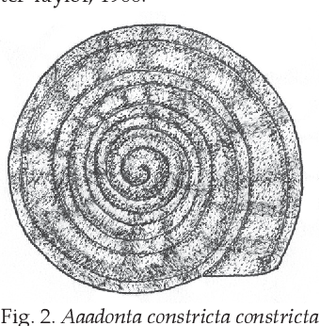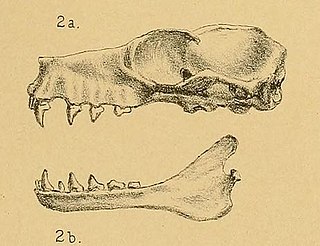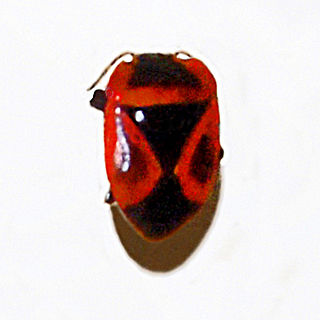Related Research Articles

Mesotardigrada is one of three classes of tardigrades, consisting of a single species, Thermozodium esakii. The animal reportedly has six claws of equal length at each foot. This species was described in 1937 by German zoologist Gilbert Rahm from a hot spring near Nagasaki, Japan. The inability of taxonomists to replicate Rahm's finding has cast doubt on the accuracy of the description, making T. esakii, and by extension the entire class Mesotardigrada, a taxon inquirendum.

Aaadonta constricta is a species of land snail, a terrestrial pulmonate gastropod mollusk in the family Endodontidae. It is endemic to Palau, where it is known from the islands of Babeldaob, Ngemelis, Peleliu and Koror. It may be extirpated from Koror. It is threatened by habitat destruction and modification.

Epomophorus is a genus of bat in the family Pteropodidae. They have a distribution throughout Africa.

Nyctimene is a genus of bats in the Pteropodidae family. Commonly known as tube-nosed fruit bats, they are found in the central Philippines, eastern Indonesia, Papua New Guinea and the north-east coast of Australia.

Aaata is a genus of beetles belonging to the family Buprestidae, containing the single species Aaata finchi. It is found in Balochistan and is one of the largest species of the family Buprestidae, reaching up to 7 cm (2.8 in) in length.
Eprhopalotus is a genus of hymenopteran insects of the family Eulophidae. Their distribution varies between species but ranges from Costa Rica, Mexico to Texas. There are currently 5 species of Eprhopalotus:
Aaages is a genus of beetle in the family Coccinellidae. The original spelling used for the type species, Aaages prior, has frequently been misspelled in the subsequent literature.
Aagaardia is a genus of fly in the Chironomidae family. Aagaardia has been found in Finland, the mainland of Norway and Russia.
Aaglacrinus is an extinct genus of crinoidea in the Cladia order. It has been proposed that it was a stationary (attached) suspension feeder the hard parts of which were composed of magnesium calcite.
Aglaocrinus is an extinct species of crinoids in the Cladia order. It has been proposed that it was a blind, stationary (attached) suspension feeder the hard parts of which were composed of magnesium calcite. It has been discovered in 3 locations in North America.
Chodsigoa is a genus of shrews in the tribe Nectogalini.

Van Sung's shrew, also known as Cao Van Sung mountain shrew is a species of shrew in the Soricomorpha order. Specimens of Chodsigoa caovansunga have been found in Vietnam.

The Katanglad shrew-mouse, also known as the Kitanglad shrew-mouse is a species of rodent in the family Muridae. It is known only from one specimen taken at 2250 m on Mount Kitanglad, Bukidnon Province, Philippines.

The Maghreb garden dormouse is a nocturnal species of rodent in the family Gliridae. It is found in Algeria, Libya, Morocco, Tunisia and Western Sahara. Its natural habitats vary from humid forests to semi-deserts. It is a common species and the International Union for Conservation of Nature has rated it as being of "least concern".
Episoriculus is a genus of shrew in the red-toothed shrew subfamily. Its common is brown-toothed shrew. It has been described as a subgenus to Soriculus in the past. The genus occurs at a number of locations in Asia, including Nepal and China.

The minor epauletted fruit bat is a species of megabat in the family Pteropodidae. It is found in Zambia, Tanzania, Mozambique and Kenya.
Aaka is a genus of hemiptera in the leafhopper family. There is only one species described in this genus, known as Aaka coera. It is distributed in Papua New Guinea.
Aalatettix is a genus of groundhopper, in the family Tetrigidae, with species found in southern China.

Dismegistus is a genus of true bugs belonging to the family Parastrachiidae.
Paranyctimene is a genus of bats in the family Pteropodidae. They are distributed in Indonesia
References
- 1 2 "Paleobiology Database: Aacocrinus". Paleodb.org. Retrieved 2013-10-20.
- ↑ "FAMILY : Actinocrinitidae Austin & Austin, 1842 : SUBFAMILY : Actinocrinitidaeincertae : GENUS : Glaphyrocrinus I. D. Lindley, 1988:130 : TYPE SPECIES : Glaphyrocrinus expansus I. D. Lindley, 1988 [species]". Insects.tamu.edu. Archived from the original on 2012-10-22. Retrieved 2013-10-20.
- ↑ "Nomenclator Zoologicus Record Detail". Ubio.org. Retrieved 2013-10-20.
- ↑ "Namebank Record Detail". Ubio.org. 2005-12-09. Retrieved 2013-10-20.
- ↑ "ION: Index to Organism Names". Organismnames.com. 1999-06-30. Retrieved 2013-10-20.
- ↑ "ION: Index to Organism Names". Organismnames.com. 2004-12-30. Archived from the original on 2012-02-25. Retrieved 2013-10-20.
- ↑ Carboniferous (Visean-Moscovian) echinoderms from the Bechar Basin area of western Algeria. Bulletins of American Paleontology, 368, December 30, 2004: 1-98. [Zoological Record Volume 142]
- ↑ "ION: Index to Organism Names". Organismnames.com. Archived from the original on 2012-02-25. Retrieved 2013-10-20.
- ↑ "ION: Index to Organism Names". Organismnames.com. Archived from the original on 2012-02-25. Retrieved 2013-10-20.
- ↑ "ION: Index to Organism Names". Organismnames.com. Archived from the original on 2012-02-25. Retrieved 2013-10-20.
- ↑ "ION: Index to Organism Names". Organismnames.com. Archived from the original on 2012-02-25. Retrieved 2013-10-20.
- ↑ "ION: Index to Organism Names". Organismnames.com. Archived from the original on 2012-02-25. Retrieved 2013-10-20.
- ↑ "ION: Index to Organism Names". Organismnames.com. Archived from the original on 2012-02-25. Retrieved 2013-10-20.
- ↑ "ION: Index to Organism Names". Organismnames.com. Archived from the original on 2012-02-25. Retrieved 2013-10-20.
- ↑ "ION: Index to Organism Names". Organismnames.com. Archived from the original on 2012-02-25. Retrieved 2013-10-20.
- ↑ "ION: Index to Organism Names". Organismnames.com. Archived from the original on 2012-02-25. Retrieved 2013-10-20.
- ↑ "ION: Index to Organism Names". Organismnames.com. Archived from the original on 2012-02-25. Retrieved 2013-10-20.
- ↑ "ION: Index to Organism Names". Organismnames.com. Archived from the original on 2012-02-25. Retrieved 2013-10-20.
- ↑ "ION: Index to Organism Names". Organismnames.com. Archived from the original on 2012-02-25. Retrieved 2013-10-20.
- ↑ "ION: Index to Organism Names". Organismnames.com. Archived from the original on 2012-02-25. Retrieved 2013-10-20.